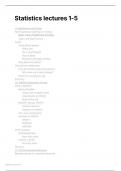Class notes
Lecture notes (1-5) Statistical Methods (semester 2)
- Course
- Institution
Lecture notes 1-5 from the second semester of Research Methods. Full, detailed notes that are essential for upcoming exams. Made in Notion and complete with a sleek, readable design (includes contents, headings, images and summaries).
[Show more]




